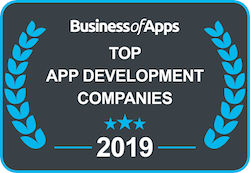At Red C, we help a wide range of clients streamline their internal operations by digitising their business processes this often includes a mobile solution as part of the process. Mobile web usage has taken over desktop browsing as the main way consumers access information; showing that now, more than ever, is the time to introduce a digital tool in the workplace.

Whether you’re a startup with an original idea, or a large corporation looking to simplify daily tasks for employees, it is essential that each and every project starts with an App Requirements Brief. For app developers such as ourselves, there is nothing more frustrating than a brilliant idea that hasn’t been thought through logically. We understand that users seek fast digital solutions that fit into their daily lives, therefore it is important to consider all the features of your app and their functionalities before the development process begins. A clear App Brief makes the development process much smoother as it gives us a greater understanding of requirements to ensure your app reaches its full potential once it is live in the app stores. This article outlines all the areas that must be thought through carefully when putting together your App Brief.
Remember; the clearer your App Brief, the quicker we can work on turning those requirements into a reality to help your business achieve its long-term goals.
Focus on solving a problem
The main purpose of building any digital solution is to overcome a problem and make business processes more efficient. The power of apps lie in their capability to connect people and share intelligent data, therefore it is important that you pinpoint what area of your business would thrive most with these improvements. For example, Ductclean approached Red C to find a solution to their increasingly inefficient paper-based systems which were slow and outdated. We designed and developed a suite of mobile apps which digitised Ductlean’s paper-based systems with a user-friendly backend enabling admins to manage and schedule jobs. This has been a massive success by dramatically increasing the efficiency of the business and helping Ductclean secure new clients who were impressed with the transparency of the work. If you’re a corporate, SME or established business in need of digital transformation then perhaps this example will resonate with you as your business may benefit from streamlining internal processes with a digital solution. However, if you’re a startup or your a business targeting consumers then you need to ensure that your product is solving a substantial issue and that this issue is best solved with a digital solution. For example, YoungPlanet approached Red C to build a mobile app to address the inherent waste and product obsolescence in the UK by helping parents with the movement of unwanted children’s clutter via a mobile app.
Research your target market
With competition tougher than ever before, it is key that your app is aimed at a target market. The more you know about your potential users, the more effectively our developers can tailor your app to their needs. This requires serious research on demographics. Make sure to know the location, age, and sex of your users as the tone of your app will depend on these factors. Also, think about what your users do on a day to day basis. Are they professionals / students / singles? And what is it that this group of people are looking to gain from using your app? As experienced developers, we know that the look and feel of your app is just as important to users as the service it offers. Therefore this is a major part of your app brief that will play into the design and determine the language that is used for your app.

Choose your platform carefully
Within the development process, choosing the right platform is a crucial decision that can enhance your app’s purpose and functionality. There are four coding methodologies you can choose from, these being: Native iOS/Android development, HTML5 development, Hybrid development (Native and HTML5), and a Web version.
Native iOS/Android apps are specific to the platforms they are developed on. This means that they use the development tools and language that the given platform supports, such as Xcode and for iOS. Consequently, we recommend that if your app requires the use of complex features that use the phone’s native functionality (e.g. Camera), this is the best option for you. This platform is the fastest, most responsive with graphics, and provides the best overall user experience. However, it is the most expensive development option.
Progressive Web apps are cross platform apps. This means that code can be reused and opened across any browser or device. If your app is very simple and content-based, we suggest using this platform as it is significantly cheaper and faster to develop.
Hybrid apps are a mix of Native iOS/Android and HTML5 development. They are typically described as web apps and take a highly skilled design and development team to create a seamless user experience. Once done well, it can be hard to tell the difference between a Hybrid app and a Native app, thus it is the second most expensive development option.
A Web version of your app is also a development option to consider. If your app is targeted at consumers then maybe this is not a priority. However, if it is targeted at business users you may want to have this. Your web version may be a simplified version of your app, to make steps like registration, forms and payments clearer on a desktop.
Core features
Describing the core features is the most important part of your brief, as this will outline the basic functionalities of your app. Think through the whole user journey from start to finish. What screens will your app have and what are their specific functionalities? Where will your buttons be on the screen and where will they lead to? And how many screens are there altogether? Consider what will be the most efficient experience for your user, and make your choices based on this. If you can provide your developers with wireframes or visuals, this would be a huge help. If not, your UX/UI designer can help you with this in the design stage, but it is always useful to include in your App Brief if possible. It may be useful to start prioritising your features based on the value that each feature will add to the overall product. We can help you define your essential features and clarify the less important features that can be rolled-out at a later phase of development during the concept refinement stage of the discovery and design process.
Have a design idea
Having a design in mind is always beneficial so that your UX/UI designer has something to work with. You want to create the right look and feel for your app, so make sure to consider what will be most appealing to your target audience. If you’re a company, you may want to use your existing brand colours and font for consistency. However, if you’re a startup, this is a new and exciting stage that calls for a creative flare. Yet again, research is key; If your app is aimed at professionals, maybe dark colours and formal language is best? / If your app is aimed at students, maybe light colours with casual language is best? (One way of gaining inspiration and showing you developers what you want is looking at other similar apps you like the design of.)
Content
It is also important to consider where the content for your app will be sourced. Will you provide this? Or will the information be provided by a third party? And if so, do you have copyright to the material? It is important to be aware that images searched through google are often subject to copyright. So it may be best to use an image library if you require stock images for your app. RSS feeds are a common source of content and are normally free to use within your app. If your content is coming from an existing website, you will need to provide an API to enable the app to display this content.
Budget & timeframe
Having a realistic budget for your app is essential. Depending on how complex your app is, the price can vary drastically. Most app projects require a backend system to manage the data within the app, as well as a Native iOS and Android app build. In addition, when you consider the design work, testing, and project management, a typical app might have a team of 7-10 people working on its development at any given time. Bearing this in mind, it is understandable that app projects often cost an excess of £20,000. Furthermore, although it is possible to develop an app quickly, it is more important to get the user experience and the design right before any coding starts. This phase might take 4-6 weeks in itself. When you add the development and testing phases, we find that most app projects take 3-6 months to complete.
Social connections
Another part of your brief should include Social Connections. This means deciding whether or not you would like your users to have the opportunity to log in to your app using Facebook, Twitter, LinkedIn or other social media platforms. A major part of your app’s success depends on how easy it is to register, share and connect with others, so this is a popular option that is often forgotten in the App Brief!
3rd party integrations and API’s
If you are a company with an existing database, you may want to consider connecting this to your app. Here at Red C, we are happy to work with your existing system to improve its functionality with an app. An API is typically defined as a set of Hypertext Transfer Protocol (HTTP) request messages, which is usually in an Extensible Markup Language (XML) or JavaScript Object Notation (JSON) format. Red C have worked with 100’s of APIs from third party providers, to in-house IT departments. Our skilled developers can customise your API or create a new one from scratch, should you require this service. All our custom APIs are developed to industry standards, ensuring they are secure and stable. All APIs are hosted on a secure server, with a SSL certificate to ensure all data is encrypted as it travels from the app to the backend. All APIs have token based authentication to ensure the highest level of security. Red C have extensive experience of developing and working with REST (JSON) and SOAP API (XML).
Security
Different apps have different security requirements. Broadly, the more security required, the more expensive the app will be to build and maintain, however, there are a number of practices we employ as standard when setting up systems with user accounts, passwords & general server security. For new apps/systems, we advise using third party services to take care of any information or process which requires a high level of security. This reduces the risk to the app owner and reduces the initial systems administration burden. Key examples of this are using drop-in solutions for payments like Paypal or Stripe. Using these integrations means that no financial data about the customer will be stored on your server, and therefore you can be confident that your customer’s data is secure without having to ensure your system is fully PCI compliant.
Part of our commitment to security is a standard practice that unless specifically required for a project, we do not store personally identifiable information locally in-app or on our servers. We work with security partner Dionach to perform security audits of systems we build. Dionach will provide a list of any issues found and suggested steps to improve the security of the system. This provides confidence to all parties involved that our systems are built using best practices.
If you have any questions regarding your brief or would like a sample template of a Red C App Requirements Brief please feel free to email me at georgia.papaspyrou@red-c.co.uk.



